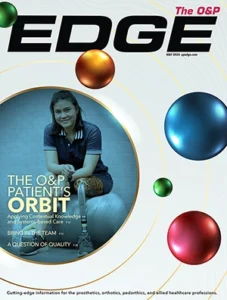In response to yesterday’s post by Brittany Stresing inquiring about 3D
printing and Ohio, I am posting the following edited version of an article
sent earlier to our Ohio P and O community.
3-D Printing of Prostheses Issue – A New Challenge for Ohio’s OT/PT/AT
State Board and OPP Advisory Council
*Assistive or Prosthetic Device ?*
A provision in Ohio’s Biennial Budget contained language intended to offer
“flexibility†for people like Aaron Westbrook (Form5 founder, Columbus) to
engage in 3-D printing of open source kits (for prostheses). The initiative
was intended to make it easier for individuals to “innovate in the field of
prosthetic-device design.†1
Westbrook caught the attention of Lt. Governor Jon Husted (Common Sense
Initiative) and Senator Robert McColley (R Dist 1), who sponsored the late,
fast-track amendment in Ohio’s Biennial Budget bill. McColley and Husted
announced the 3-D amendment during a June press conference with no prior
communication with the professional prosthetic practitioner community.
Unfortunately several misleading and inaccurate statements were made about
the prosthetic community, leaving the audience with less than positive
impressions about the prosthetic profession.
The Ohio Orthotics and Prosthetics Association (OOPA) and members contacted
both Sen. McColley and the office of Lt. Governor Husted voicing concerns
about the misinformation. Responses were weak with no public apology to
date. An individual from Ohio’s Common Sense Initiative did offer a verbal
apology saying that they should have done a better job of communicating and
planning for the pending amendment and that they didn’t intend for any of
the statements or implied perceptions to be insulting to the profession.
Attempts were made to persuade Sen. McColley to include additional language
to his amendment that would restrict the 3D devices to upper limb
prosthetics. His “preference†was to leave the amendment as written,
suggesting that oversight could be addressed by rule through the OT/PT/AT
Board.
It is clear that 3-D printing is a wave of the future in health care. Its
features can offer flexibility, affordability, innovation, and
customization in areas such as surgery, anatomical models, bio-implantable
organs, pharma and more, all exciting areas of medical application.
What is not clear, however, is how to regulate or provide oversight for the
use of 3D printed medical devices. A recent webinar was given by attorney
Daniel Tranen (MedMarc) titled 3D Printing of Medical Devices: What the
Future Holds for Regulating and Litigating Medical Device Failures for
Point of Service Manufacturers and Users
.
Attorney Tranen made it clear that the growth of 3D printed medical devices
will escalate increasingly as the costs decrease (lower cost for printers,
etc.). According to Tranen, an increasing number of hospitals are acquiring
3D printing companies. Questions with no clear answers hang out there, such
as “Who is liable for a bad outcome?†or “Is Anyone Liable?†when, for
example a doctor uses a custom 3D printed scalpel in a hospital setting. Is
it the hospital, doctor, the CAD design, the materials manufacturer, etc.?
The FDA hasn’t written regulations regarding 3D printing of medical devices
and Point of Service (POS) delivery. Tranen said he doesn’t expect them to
either, due to their lack of resources. He did suggest that most likely any
oversight will need to happen locally.
WHAT NOW?
Oversight of 3-D prosthetic printing will be a challenge to the prosthetic
profession. There is no road map for this newest wave of technological
change.
Ohio is now faced with how to write rules addressing 3D printed prostheses
and delivery.
The Ohio OT/PT/AT Board, the OPP Advisory Council, and a special 3D
Printing Work Group will forge new ground as they begin to write rules for
anyone who provides 3D-printed prostheses. Those parameters are yet to be
written and tested.
Mr. Westbrook went on to say in the *ThisWeek*
Northwest * news article that “The devices that he makes under Form5 could
be considered ‘assistive devices’ rather than prosthetic devices…But if
someone has the ability 3D print a leg,†he asked, ‘Why would we not call
that a prosthetic leg?’……And though the task-specific devices he
creates are not technically prosthetic devices, users should be able to
call them that if they desire.â€
Licensure provides needed oversight serving as a resource for Ohio’s
citizens to lodge a complaint or inquire about prosthetic standards. At the
same time, there are those who, like the Lt. Governor, believe licensure is
a “turf†issue and that it impedes innovation. According to Westbrook,
regulation in the existing law has “set back the prosthetic-device
industry.â€2
It is important to educate elected officials about the field of prosthetics
before issues arise so that they will better understand the complexities of
providing prosthetic care as it relates to the appropriate use of 3D
printing prostheses.
The most effective way to educate elected officials is to show them what
you do in your facilities. They are the people who may impact the future of
your profession. Invite them to your facilities, talk about prosthetic
care, introduce them to some patients and last but not least, talk about
how technological advancements (including 3D printing) offer exciting
innovations for people with limb loss.
We in Ohio welcome any professional insight(s) that may be applied to the
3D printing rule-writing process.
Feel free to direct questions or comments to:
Dianne Farabi
Executive Director
Ohio Orthotics and Prosthetics Association
(614) 659-0197
(614) 336-8596 fax
(614) 946-7467 cell
1 As reported July 25, 2019 *ThisWeek Hillard Northwest News*, “Form5
founder still focused on helping othersâ€.
2 As reported July 25, 2019 *ThisWeek Hillard Northwest News*, “Form5
founder still focused on helping othersâ€.
This Week News Hilliard
https://urldefense.proofpoint.com/v2/url?u=https-3A__www.thisweeknews.com_news_20190713_form5s-2Daaron-2Dwestbrook-2Dhelping-2Dothers-2Dwith-2Dtask-2Doriented-2Dprosthetic-2Ddevices&d=DwIFaQ&c=sJ6xIWYx-zLMB3EPkvcnVg&r=KmuawjwNpT9A2bnhzaNVjw8wO7L_TDosEXIk33h_tlw&m=yfYxkrpHRRoz6ba3oAa4WuHMsszQeMPYpDjjf1NF-4M&s=_scITW3mI791gZoq78wWyqA8CpWUHKT5Z1o0w7WOOSI&e=
View the Medmarc Webinar Slides
https://urldefense.proofpoint.com/v2/url?u=https-3A__www.medmarc.com_globalassets_news-2Dand-2Dresources_webinars_slides_19-2D07-2D-2D-2Dmedmarc-2Dwebinar-2D3d-2Dprinting-2Dof-2Dmedical-2Ddevices-2Dslides.pdf&d=DwIFaQ&c=sJ6xIWYx-zLMB3EPkvcnVg&r=KmuawjwNpT9A2bnhzaNVjw8wO7L_TDosEXIk33h_tlw&m=yfYxkrpHRRoz6ba3oAa4WuHMsszQeMPYpDjjf1NF-4M&s=xExo6lRFjXxNmRaCBGBi8gvnr0NHYByC9gOxzVRd478&e=



